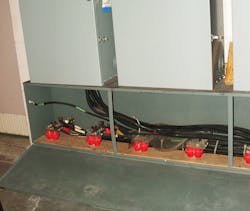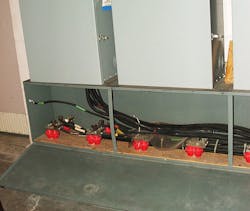How well do you know the Code? Think you can spot violations the original installer either ignored or couldn't identify? Here's your chance to moonlight as an electrical inspector and second-guess someone else's work from the safety of your living room or office. It's your turn to identify the violation.
Hint: Hide-and-seek surprise
Find the Answer
Discovering what’s behind this metal wireway cover would surprise most electricians. Those are exposed foot lug connectors energized at 480V installed on insulators that are secured to plywood installed in the bottom of the wireway. This could quickly become a disaster for the unsuspecting electrician who opens this cover without knowing what lurks behind it.
Section 376.56(B)(4) does not permit power distribution blocks installed in metal wireways to have any uninsulated energized parts exposed within the wireway. I believe this installation violates the intent of that Code section.
The wire bending space required by Sec. 376.56(B)(3) is also questionable where the conductors enter the connectors. A few of those terminals seem a little too close to the back of the wireway.
In violation of Sec. 376.56(B)(5), several of the terminal blocks are obstructed by other conductors laying right on top of the terminals. This can make it very difficult to access the terminals.
The use of plywood leaves me wondering if it is fire-retardant, or is it combustible? If the plywood is combustible that could be a real problem if there were a short circuit or an accidental ground fault in the wireway and some sparks were to ignite the plywood. A 4th of July type fireworks show would begin shortly thereafter. And, of course, there is always Sec. 110.12, which requires neat and workmanlike installations. I am not so sure that has happened here.
About the Author

Russ LeBlanc
Owner
Russ started in the electrical trade as an apprentice in 1985. He worked his way up to become a Journeyman Electrician and then eventually became a Master Electrician and Licensed Construction Supervisor. In 1999 Russ become an Electrical Instructor for The Peterson School of Engineering in Massachusetts where he developed his passion for teaching, and quickly became Department Head of Electrical Instruction. Russ has taught thousands of apprentices, electricians, engineers, inspectors, and other electrical professionals during his career as an instructor. He continues to provide electrical professionals with Electrical Code seminars, Arc-Flash Awareness training seminars and educational material through his LeBlanc Consulting Services in North Reading, MA whose specialty is educating electricians. He has been an active member of the NFPA Electrical Section and has authored hundreds of National Electrical Code proposals and comments which have become Code rules to improve the safety for the electrical industry. Russ is also an IAEI certified Electrical Inspector.
Please visit www.russleblanc.net for more information.

